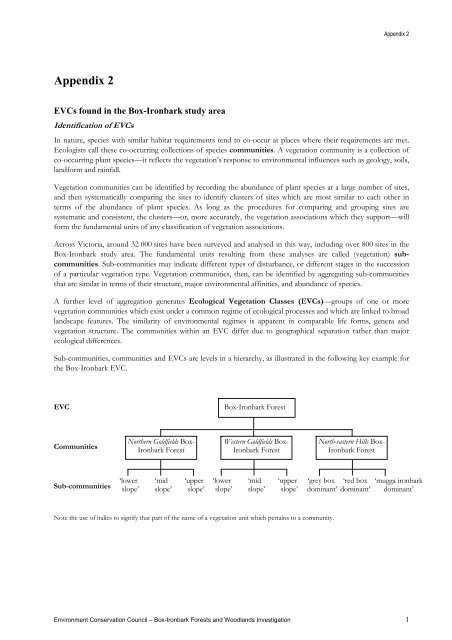Appendix 1 - Victorian Environmental Assessment Council
Appendix 1 - Victorian Environmental Assessment Council
Appendix 1 - Victorian Environmental Assessment Council
You also want an ePaper? Increase the reach of your titles
YUMPU automatically turns print PDFs into web optimized ePapers that Google loves.
<strong>Appendix</strong> 2<br />
EVCs found in the Box-Ironbark study area<br />
Identification of EVCs<br />
<strong>Appendix</strong> 2<br />
In nature, species with similar habitat requirements tend to co-occur at places where their requirements are met.<br />
Ecologists call these co-occurring collections of species communities. A vegetation community is a collection of<br />
co-occurring plant species—it reflects the vegetation’s response to environmental influences such as geology, soils,<br />
landform and rainfall.<br />
Vegetation communities can be identified by recording the abundance of plant species at a large number of sites,<br />
and then systematically comparing the sites to identify clusters of sites which are most similar to each other in<br />
terms of the abundance of plant species. As long as the procedures for comparing and grouping sites are<br />
systematic and consistent, the clusters—or, more accurately, the vegetation associations which they support—will<br />
form the fundamental units of any classification of vegetation associations.<br />
Across Victoria, around 32 000 sites have been surveyed and analysed in this way, including over 800 sites in the<br />
Box-Ironbark study area. The fundamental units resulting from these analyses are called (vegetation) subcommunities.<br />
Sub-communities may indicate different types of disturbance, or different stages in the succession<br />
of a particular vegetation type. Vegetation communities, then, can be identified by aggregating sub-communities<br />
that are similar in terms of their structure, major environmental affinities, and abundance of species.<br />
A further level of aggregation generates Ecological Vegetation Classes (EVCs)—groups of one or more<br />
vegetation communities which exist under a common regime of ecological processes and which are linked to broad<br />
landscape features. The similarity of environmental regimes is apparent in comparable life forms, genera and<br />
vegetation structure. The communities within an EVC differ due to geographical separation rather than major<br />
ecological differences.<br />
Sub-communities, communities and EVCs are levels in a hierarchy, as illustrated in the following key example for<br />
the Box-Ironbark EVC.<br />
EVC<br />
Communities<br />
Sub-communities<br />
Northern Goldfields Box-<br />
Ironbark Forest<br />
‘lower<br />
slope’<br />
‘mid<br />
slope’<br />
‘upper<br />
slope’<br />
‘lower<br />
slope’<br />
Box-Ironbark Forest<br />
Western Goldfields Box-<br />
Ironbark Forest<br />
‘mid<br />
slope’<br />
‘upper<br />
slope’<br />
Note the use of italics to signify that part of the name of a vegetation unit which pertains to a community.<br />
North-eastern Hills Box-<br />
Ironbark Forest<br />
‘grey box<br />
dominant’<br />
‘red box<br />
dominant’<br />
‘mugga ironbark<br />
dominant’<br />
Environment Conservation <strong>Council</strong> – Box-Ironbark Forests and Woodlands Investigation 1
















